Unveiling Sustainable Potential: A Life Cycle Assessment of Plant–Fiber Composite Microcellular Foam Molded Automotive Components
Abstract
:1. Introduction
2. Materials and Methods
2.1. Goal and Scope Definition
2.2. Life Cycle Inventory Analysis
2.2.1. Extraction and Processing Stages of Plant Fiber
2.2.2. Preparation Stage of Masterbatches for Plant–Fiber-Reinforced PP Composites
2.2.3. Microcellular Foam Injection Molding Stage for Automotive Parts
2.3. Life Cycle Impact Assessment
2.4. Sensitivity Analysis
3. Results and Discussion
3.1. The Results of Environmental Impact Indicator Characterization
3.1.1. Ecotoxicity Depletion
3.1.2. Ozone Depletion
3.1.3. Eutrophication Depletion
3.1.4. Resource Depletion
3.2. Climate Change
3.3. The Results of Sensitivity Analysis
4. Conclusions
Author Contributions
Funding
Institutional Review Board Statement
Informed Consent Statement
Data Availability Statement
Conflicts of Interest
Appendix A
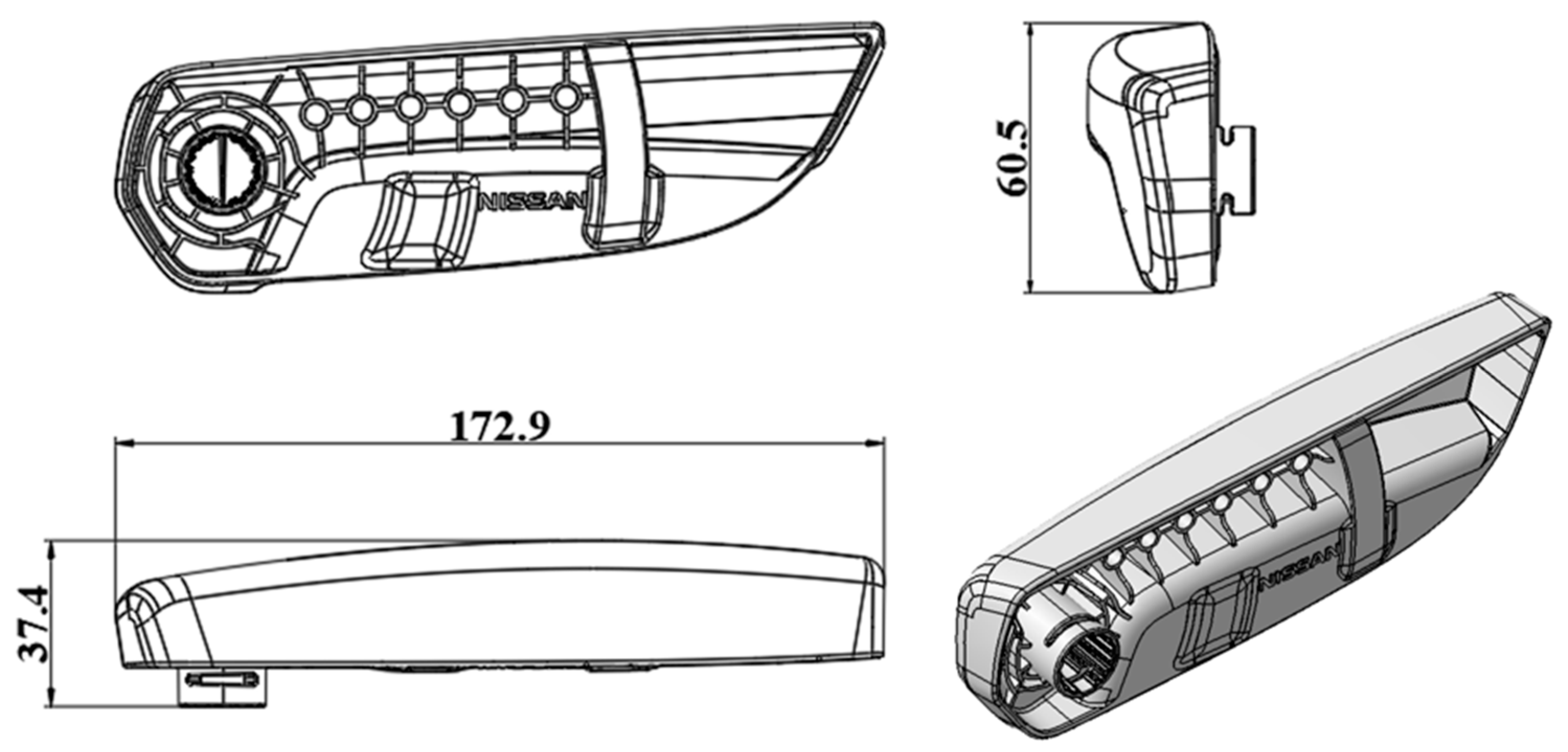

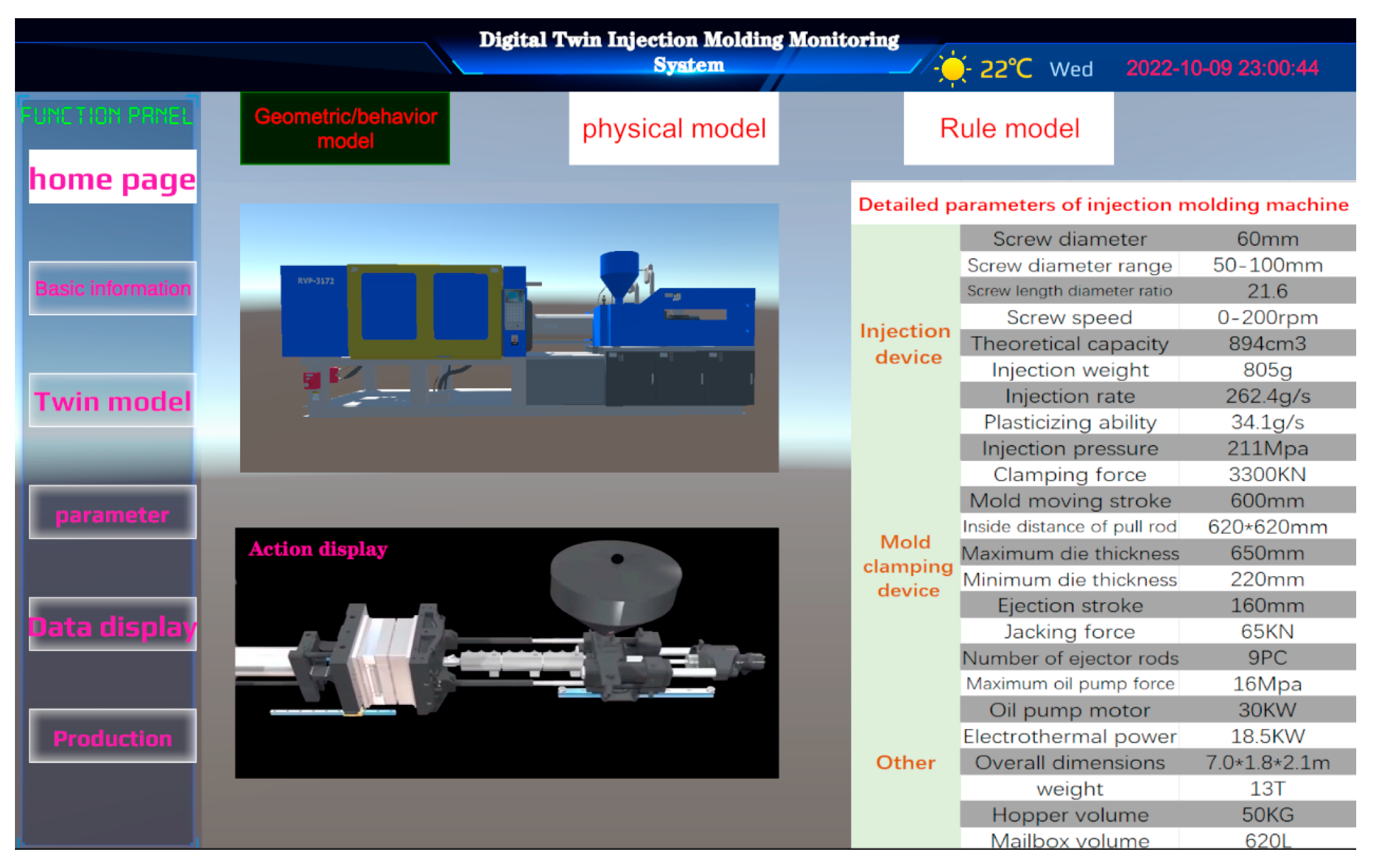
References
- Ravishankar, B.; Nayak, S.K.; Kader, M.A. Hybrid Composites for Automotive Applications—A Review. J. Reinf. Plast. Compos. 2019, 38, 835–845. [Google Scholar] [CrossRef]
- Kumar, B.R.; Srimannarayana, C.H.N.; Krishnan, K.A.; Hariharan, S.S. Experimental Evaluation on Comparative Mechanical Properties of Jute—Flax Fibre Reinforced Composite Structures. Struct. Eng. Mech. 2020, 74, 515–520. [Google Scholar] [CrossRef]
- Ghosh, T.; Kim, H.C.; De Kleine, R.; Wallington, T.J.; Bakshi, B.R. Life Cycle Energy and Greenhouse Gas Emissions Implications of Using Carbon Fiber Reinforced Polymers in Automotive Components: Front Subframe Case Study. Sustain. Mater. Technol. 2021, 28, e00263. [Google Scholar] [CrossRef]
- Sanjay, M.R.; Siengchin, S.; Parameswaranpillai, J.; Jawaid, M.; Pruncu, C.I.; Khan, A. A Comprehensive Review of Techniques for Natural Fibers as Reinforcement in Composites: Preparation, Processing and Characterization. Carbohydr. Polym. 2019, 207, 108–121. [Google Scholar] [CrossRef]
- Madhu, P.; Sanjay, M.R.; Senthamaraikannan, P.; Pradeep, S.; Siengchin, S.; Jawaid, M.; Kathiresanf, M. Effect of Various Chemical Treatments of Prosopis Juliflora Fibers as Composite Reinforcement: Physicochemical, Thermal, Mechanical, and Morphological Properties. J. Nat. Fibers 2020, 17, 833–844. [Google Scholar] [CrossRef]
- Pappu, A.; Pickering, K.L.; Thakur, V.K. Manufacturing and Characterization of Sustainable Hybrid Composites Using Sisal and Hemp Fibres as Reinforcement of Poly (Lactic Acid) via Injection Moulding. Ind. Crops Prod. 2019, 137, 260–269. [Google Scholar] [CrossRef]
- Faruk, O.; Bledzki, A.K.; Fink, H.-P.; Sain, M. Biocomposites Reinforced with Natural Fibers: 2000–2010. Prog. Polym. Sci. 2012, 37, 1552–1596. [Google Scholar] [CrossRef]
- Ageyeva, T.; Bárány, T.; Karger-Kocsis, J. Composites. In Polypropylene Handbook: Morphology, Blends and Composites; Karger-Kocsis, J., Bárány, T., Eds.; Springer International Publishing: Cham, Switzerland; Berlin/Heidelberg, Germany, 2019; pp. 481–578. ISBN 978-3-030-12903-3. [Google Scholar]
- Hamidinejad, M.; Zhao, B.; Zandieh, A.; Moghimian, N.; Filleter, T.; Park, C.B. Enhanced Electrical and Electromagnetic Interference Shielding Properties of Polymer-Graphene Nanoplatelet Composites Fabricated via Supercritical-Fluid Treatment and Physical Foaming. ACS Appl. Mater. Interfaces 2018, 10, 30752–30761. [Google Scholar] [CrossRef]
- Zhao, J.; Wang, G.; Wang, C.; Park, C.B. Ultra-Lightweight, Super Thermal-Insulation and Strong PP/CNT Microcellular Foams. Compos. Sci. Technol. 2020, 191, 108084. [Google Scholar] [CrossRef]
- Yang, Q.; Guo, W.; Meng, Z.; Mao, H.; Hua, L.; Liu, Y. Investigation on Forming Defects and Crystallization of Plastic Parts in Combined In-Mold Decoration and Microcellular Injection Molding Based on a Multiphase Flow-Solid Coupled Heat Transfer Model. Int. J. Heat Mass Transf. 2020, 151, 119285. [Google Scholar] [CrossRef]
- Yan, K.; Guo, W.; Mao, H.; Yang, Q.; Meng, Z. Investigation on Foamed PP/Nano-CaCO3 Composites in a Combined in-Mold Decoration and Microcellular Injection Molding Process. Polymers 2020, 12, 363. [Google Scholar] [CrossRef] [PubMed] [Green Version]
- Alves, C.; Ferrao, P.M.C.; Silva, A.J.; Reis, L.G.; Freitas, M.; Rodrigues, L.B.; Alves, D.E. Ecodesign of Automotive Components Making Use of Natural Jute Fiber Composites. J. Clean. Prod. 2010, 18, 313–327. [Google Scholar] [CrossRef]
- Saba, N.; Paridah, M.T.; Jawaid, M. Mechanical Properties of Kenaf Fibre Reinforced Polymer Composite: A Review. Constr. Build. Mater. 2015, 76, 87–96. [Google Scholar] [CrossRef]
- Kabir, M.M.; Wang, H.; Lau, K.T.; Cardona, F. Chemical Treatments on Plant-Based Natural Fibre Reinforced Polymer Composites: An Overview. Compos. Part B Eng. 2012, 43, 2883–2892. [Google Scholar] [CrossRef]
- Akil, H.M.; Omar, M.F.; Mazuki, A.A.M.; Safiee, S.; Ishak, Z.A.M.; Abu Bakar, A. Kenaf Fiber Reinforced Composites: A Review. Mater. Des. 2011, 32, 4107–4121. [Google Scholar] [CrossRef]
- Ashori, A. Wood–Plastic Composites as Promising Green-Composites for Automotive Industries! Bioresour. Technol. 2008, 99, 4661–4667. [Google Scholar] [CrossRef]
- Fortea-Verdejo, M.; Bumbaris, E.; Burgstaller, C.; Bismarck, A.; Lee, K.-Y. Plant Fibre-Reinforced Polymers: Where Do We Stand in Terms of Tensile Properties? Int. Mater. Rev. 2017, 62, 441–464. [Google Scholar] [CrossRef] [Green Version]
- Guo, W.; Yu, Z.; Wei, W.; Meng, Z.; Mao, H.; Hua, L. Effect of Film Types on Thermal Response, Cellular Structure, Forming Defects and Mechanical Properties of Combined in-Mold Decoration and Microcellular Injection Molding Parts. J. Mater. Sci. Technol. 2021, 92, 98–108. [Google Scholar] [CrossRef]
- Jiang, J.; Li, Z.; Yang, H.; Wang, X.; Li, Q.; Turng, L.-S. Microcellular Injection Molding of Polymers: A Review of Process Know-How, Emerging Technologies, and Future Directions. Curr. Opin. Chem. Eng. 2021, 33, 100694. [Google Scholar] [CrossRef]
- Gim, J.; Turng, L.-S. A Review of Current Advancements in High Surface Quality Injection Molding: Measurement, Influencing Factors, Prediction, and Control. Polym. Test 2022, 115, 107718. [Google Scholar] [CrossRef]
- Zhao, J.; Wang, G.; Chai, J.; Chang, E.; Wang, S.; Zhang, A.; Park, C.B. Polylactic Acid/UV-Crosslinked in-Situ Ethylene-Propylene-Diene Terpolymer Nanofibril Composites with Outstanding Mechanical and Foaming Performance. Chem. Eng. J. 2022, 447, 137509. [Google Scholar] [CrossRef]
- Guo, W.; Yang, Q.; Mao, H.; Meng, Z.; Hua, L.; He, B. A Combined In-Mold Decoration and Microcellular Injection Molding Method for Preparing Foamed Products with Improved Surface Appearance. Polymers 2019, 11, 778. [Google Scholar] [CrossRef] [PubMed] [Green Version]
- Abu Hassan, N.A.; Ahmad, S.; Chen, R.S.; Shahdan, D.; Kassim, M.H.M. Tailoring Lightweight, Mechanical and Thermal Performance of PLA/ Recycled HDPE Biocomposite Foams Reinforced with Kenaf Fibre. Ind. Crops Prod. 2023, 197, 116632. [Google Scholar] [CrossRef]
- Meng, Z.; Yuan, Q.; Guo, W.; Xia, Z.; Zhou, L.; Hua, L. Cellular Structure and Mechanical Strength of Straw Fiber/Polypropylene Plastics under Chemical Foam Molding. J. Text. Inst. 2021, 112, 109–116. [Google Scholar] [CrossRef]
- Li, J.; Yang, X.; Xiu, H.; Dong, H.; Song, T.; Ma, F.; Feng, P.; Zhang, X.; Kozliak, E.; Ji, Y. Structure and Performance Control of Plant Fiber Based Foam Material by Fibrillation via Refining Treatment. Ind. Crops Prod. 2019, 128, 186–193. [Google Scholar] [CrossRef]
- Rodrigues Pereira de Paula, C.; Trianoski, R.; Azevedo, E. Development and Characterization of Sawdust and Sisal Fiber Reinforced Vegetable Based Polyurethane Foam Hybrid Composites. J. Nat. Fibers 2022, 19, 3265–3274. [Google Scholar] [CrossRef]
- Qiao, J.; Li, H.; Tu, J.; Li, X.; Luo, L.; Wang, Q.; Chen, Z. Development of Plant Fibre Foam and Study of Its Thermal Insulation Properties. Coatings 2022, 12, 1256. [Google Scholar] [CrossRef]
- Arshad, F.; Lin, J.; Manurkar, N.; Fan, E.; Ahmad, A.; Tariq, M.-N.; Wu, F.; Chen, R.; Li, L. Life Cycle Assessment of Lithium-Ion Batteries: A Critical Review. Resour. Conserv. Recycl. 2022, 180, 106164. [Google Scholar] [CrossRef]
- Feng, T.; Guo, W.; Li, Q.; Meng, Z.; Liang, W. Life Cycle Assessment of Lithium Nickel Cobalt Manganese Oxide Batteries and Lithium Iron Phosphate Batteries for Electric Vehicles in China. J. Energy Storage 2022, 52, 104767. [Google Scholar] [CrossRef]
- Tian, X.; Xie, J.; Xu, M.; Wang, Y.; Liu, Y. An Infinite Life Cycle Assessment Model to Re-Evaluate Resource Efficiency and Environmental Impacts of Circular Economy Systems. Waste Manag. 2022, 145, 72–82. [Google Scholar] [CrossRef]
- Henzel, J.; Wrobel, L.; Fice, M.; Sikora, M. Energy Consumption Forecasting for the Digital-Twin Model of the Building. Energies 2022, 15, 4318. [Google Scholar] [CrossRef]
- Liu, Z.; Meyendorf, N.; Mrad, N. The Role of Data Fusion in Predictive Maintenance Using Digital Twin. In Proceedings of the 44th Annual Review of Progress in Quantitative Nondestructive Evaluation, Volume 37, Provo, UT, USA, 16–21 July 2017; Chimenti, D.E., Bond, L.J., Eds.; American Institute of Physics: Melville, Australia, 2018; Volume 1949, p. 020023. [Google Scholar]
- Fahim, M.; Sharma, V.; Cao, T.-V.; Canberk, B.; Duong, T.Q. Machine Learning-Based Digital Twin for Predictive Modeling in Wind Turbines. IEEE Access 2022, 10, 14184–14194. [Google Scholar] [CrossRef]
- Finnveden, G.; Hauschild, M.Z.; Ekvall, T.; Guinee, J.; Heijungs, R.; Hellweg, S.; Koehler, A.; Pennington, D.; Suh, S. Recent Developments in Life Cycle Assessment. J. Environ. Manag. 2009, 91, 1–21. [Google Scholar] [CrossRef] [PubMed]
- Guinee, J.B.; Heijungs, R.; Huppes, G.; Zamagni, A.; Masoni, P.; Buonamici, R.; Ekvall, T.; Rydberg, T. Life Cycle Assessment: Past, Present, and Future. Environ. Sci. Technol. 2011, 45, 90. [Google Scholar] [CrossRef] [PubMed]
- Soatthiyanon, N.; Aumnate, C.; Srikulkit, K. Rheological, Tensile, and Thermal Properties of Poly(Butylene Succinate) Composites Filled with Two Types of Cellulose (Kenaf Cellulose Fiber and Commercial Cellulose). Polym. Compos. 2020, 41, 2777–2791. [Google Scholar] [CrossRef]
- Zakikhani, P.; Zahari, R.; Sultan, M.T.H.; Majid, D.L. Extraction and Preparation of Bamboo Fibre-Reinforced Composites. Mater. Des. 2014, 63, 820–828. [Google Scholar] [CrossRef]
- Peltola, H.; Pääkkönen, E.; Jetsu, P.; Heinemann, S. Wood Based PLA and PP Composites: Effect of Fibre Type and Matrix Polymer on Fibre Morphology, Dispersion and Composite Properties. Compos. Part A Appl. Sci. Manuf. 2014, 61, 13–22. [Google Scholar] [CrossRef]
- Meng, F.; McKechnie, J.; Turner, T.; Wong, K.H.; Pickering, S.J. Environmental Aspects of Use of Recycled Carbon Fiber Composites in Automotive Applications. Environ. Sci. Technol. 2017, 51, 12727–12736. [Google Scholar] [CrossRef]
- Serra-Parareda, F.; Julián, F.; Espinosa, E.; Rodríguez, A.; Espinach, F.X.; Vilaseca, F. Feasibility of Barley Straw Fibers as Reinforcement in Fully Biobased Polyethylene Composites: Macro and Micro Mechanics of the Flexural Strength. Molecules 2020, 25, 2242. [Google Scholar] [CrossRef]
- Deng, F. Energy Consumption Analysis and Process Optimization in Microcellular Foaming Injection Molding of Automotive Trim. Master’s Thesis, Wuhan University of Technology, Wuhan, China, 2020. [Google Scholar]
- Agarski, B.; Vukelic, D.; Micunovic, M.I.; Budak, I. Evaluation of the Environmental Impact of Plastic Cap Production, Packaging, and Disposal. J. Environ. Manag. 2019, 245, 55–65. [Google Scholar] [CrossRef]
- Gu, F.; Zhang, W.; Guo, J.; Hall, P. Exploring “Internet+Recycling”: Mass Balance and Life Cycle Assessment of a Waste Management System Associated with a Mobile Application. Sci. Total Environ. 2019, 649, 172–185. [Google Scholar] [CrossRef] [PubMed]
- Quan, J.; Zhao, S.; Song, D.; Wang, T.; He, W.; Li, G. Comparative Life Cycle Assessment of LFP and NCM Batteries Including the Secondary Use and Different Recycling Technologies. Sci. Total Environ. 2022, 819, 153105. [Google Scholar] [CrossRef] [PubMed]
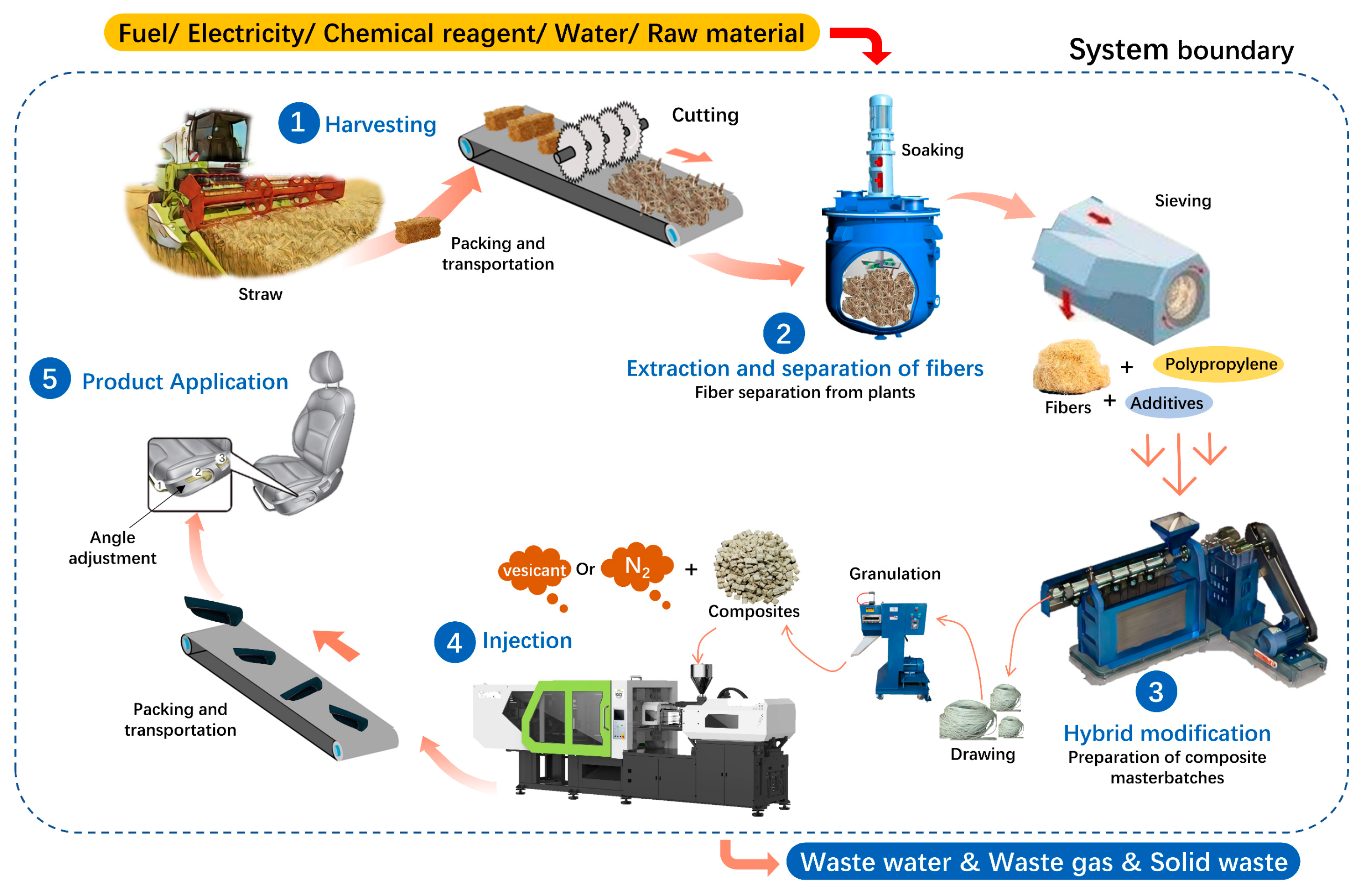
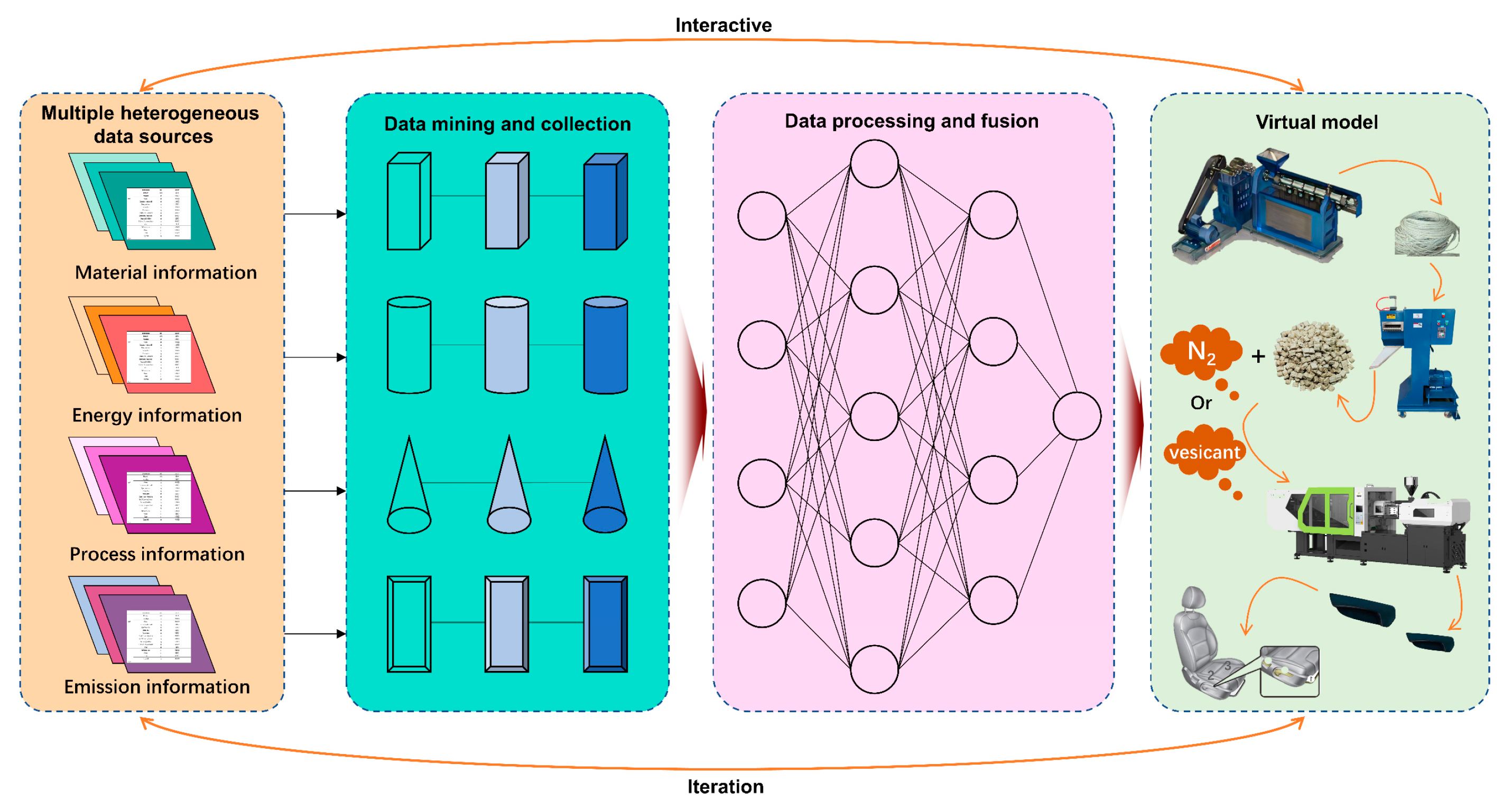
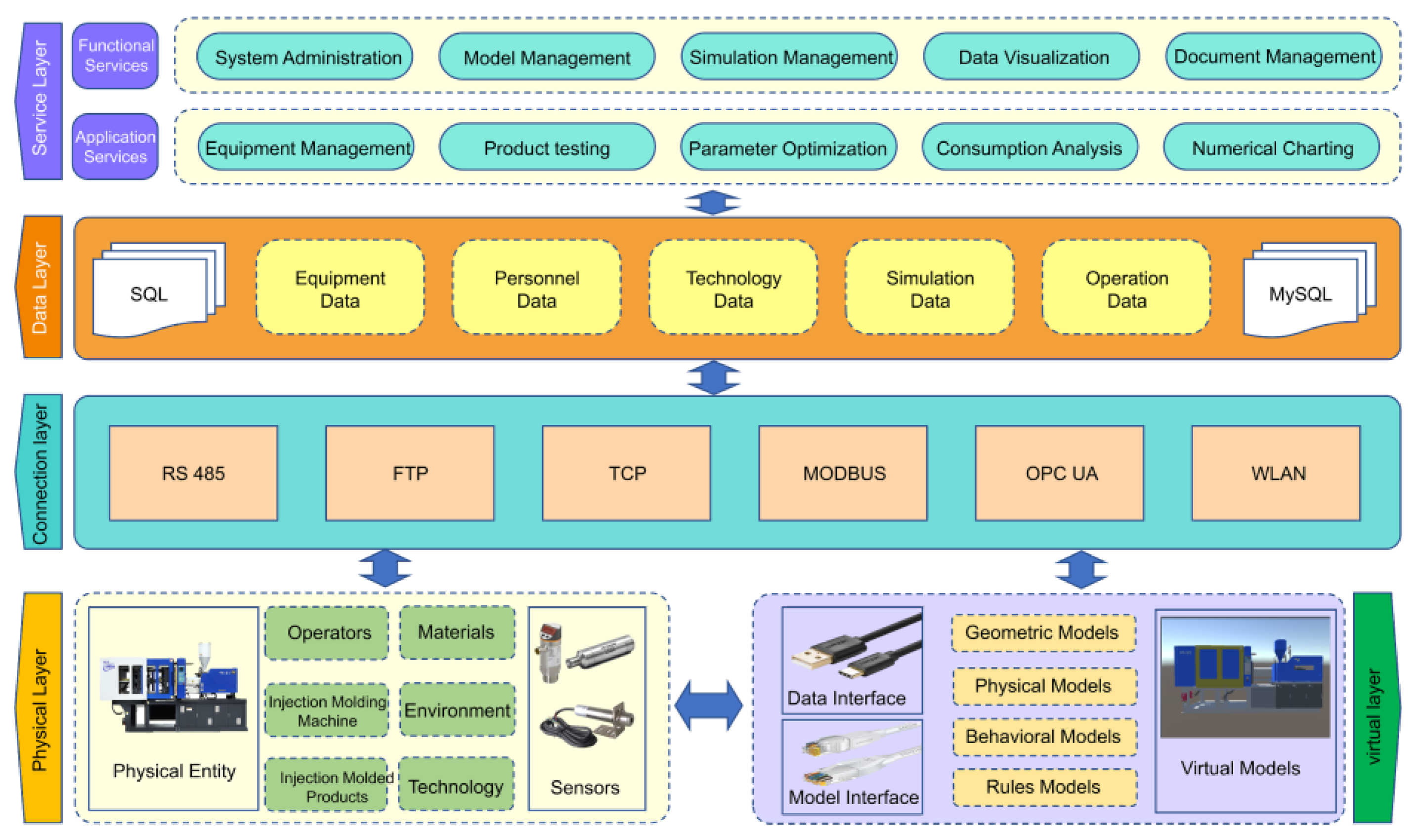





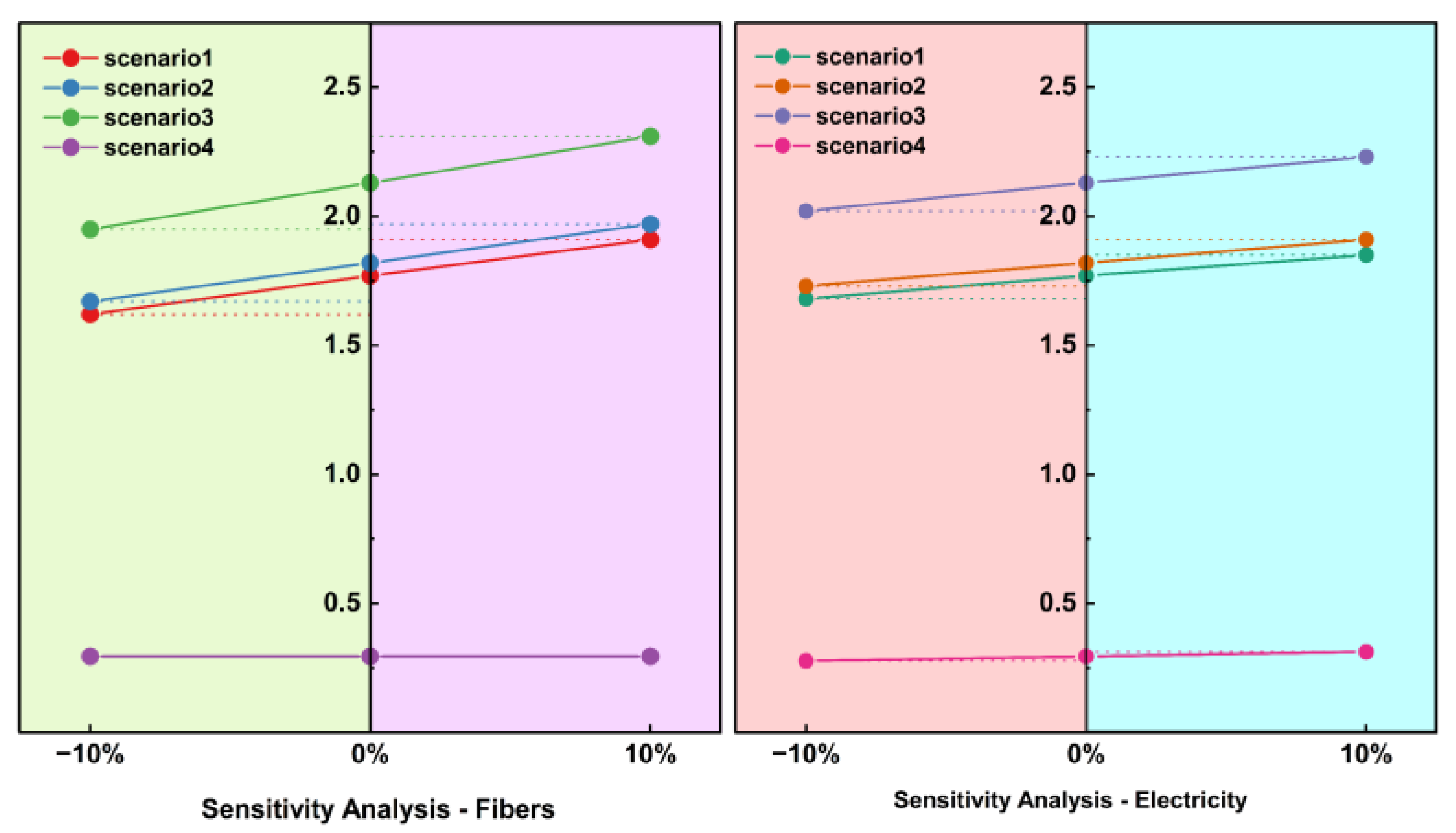
| Parameter Name | Amount | Unit | |
|---|---|---|---|
| scenario 1 | Electricity | 5.13 | kWh |
| plant–fiber composite | 0.80 | kg | |
| Water | 2.00 | kg | |
| Polypropylene | 0.20 | kg | |
| Azodicarbonamide | 0.03 | kg | |
| Zinc oxide | 0.05 | kg | |
| Molding tool | 5.26 × 10−6 | p | |
| scenario 2 | Electricity | 6.32 | kWh |
| plant–fiber composite | 0.82 | kg | |
| Water | 2.00 | kg | |
| Polypropylene | 0.20 | kg | |
| Nitrogen | 0.02 | kg | |
| Molding tool | 5.26 × 10−6 | p | |
| scenario 3 | Electricity | 4.98 | kWh |
| plant–fiber composite | 1.00 | kg | |
| Water | 2.00 | kg | |
| Polypropylene | 0.20 | kg | |
| Molding tool | 5.26 × 10−6 | p | |
| scenario 4 | Electricity | 5.24 | kWh |
| Water | 4.00 | kg | |
| Polypropylene | 1.20 | kg | |
| Molding tool | 5.26 × 10−6 | p |
| Parameter Name | Scenario 1 | Scenario 2 | Scenario 3 | Scenario 4 |
|---|---|---|---|---|
| Trials | 1000 | 1000 | 1000 | 1000 |
| Base case | 1.77 | 1.82 | 2.13 | 0.295 |
| Mean | 1.78 | 1.84 | 2.11 | 0.295 |
| Median | 1.75 | 1.80 | 2.11 | 0.292 |
| Standard deviation | 0.166 | 0.168 | 0.195 | 0.0301 |
| Standard error of mean | 5.26 × 10−3 | 5.32 × 10−3 | 6.18 × 10−3 | 9.52 × 10−4 |
| Skewness | 0.934 | 0.973 | 0.702 | 0.858 |
| Coefficient of variability | 9.39% | 9.26% | 9.18% | 10.2% |
| Minimum | 1.41 | 1.43 | 1.6 | 0.22 |
| Maximum | 2.42 | 2.48 | 3.1 | 0.431 |
Disclaimer/Publisher’s Note: The statements, opinions and data contained in all publications are solely those of the individual author(s) and contributor(s) and not of MDPI and/or the editor(s). MDPI and/or the editor(s) disclaim responsibility for any injury to people or property resulting from any ideas, methods, instructions or products referred to in the content. |
© 2023 by the authors. Licensee MDPI, Basel, Switzerland. This article is an open access article distributed under the terms and conditions of the Creative Commons Attribution (CC BY) license (https://creativecommons.org/licenses/by/4.0/).
Share and Cite
Feng, T.; Guo, W.; Li, W.; Meng, Z.; Zhu, Y.; Zhao, F.; Liang, W. Unveiling Sustainable Potential: A Life Cycle Assessment of Plant–Fiber Composite Microcellular Foam Molded Automotive Components. Materials 2023, 16, 4952. https://doi.org/10.3390/ma16144952
Feng T, Guo W, Li W, Meng Z, Zhu Y, Zhao F, Liang W. Unveiling Sustainable Potential: A Life Cycle Assessment of Plant–Fiber Composite Microcellular Foam Molded Automotive Components. Materials. 2023; 16(14):4952. https://doi.org/10.3390/ma16144952
Chicago/Turabian StyleFeng, Tao, Wei Guo, Wei Li, Zhenghua Meng, Yao Zhu, Feng Zhao, and Weicheng Liang. 2023. "Unveiling Sustainable Potential: A Life Cycle Assessment of Plant–Fiber Composite Microcellular Foam Molded Automotive Components" Materials 16, no. 14: 4952. https://doi.org/10.3390/ma16144952






